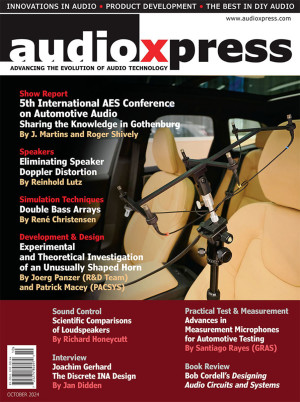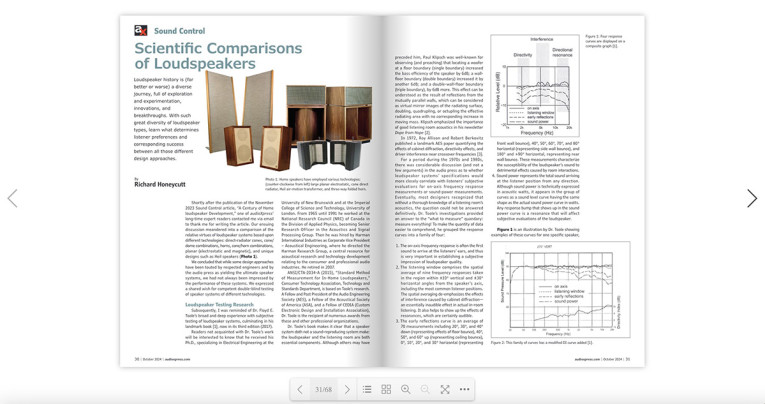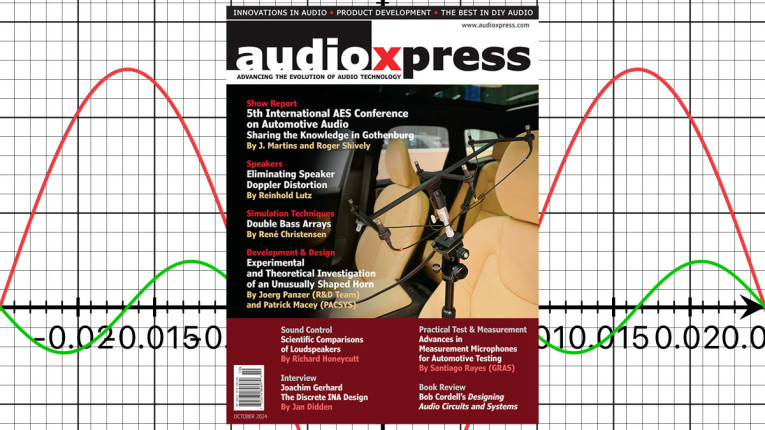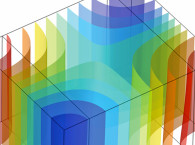 In this October 2024 issue, audioXpress closely followed the exciting 5th International Audio Engineering Society conference on Automotive Audio, in Gothenburg, Sweden, and shares a detailed report. It was an historical event for the AES, reflecting the strong momentum in the automotive sector, where audio, acoustics, and passenger-oriented applications are front and center in the transition to electric vehicles. The report, written by J. Martins and Roger Shively (who was also co-chair of the conference), expands on what could be seen on the demonstration vehicles and a selection of the paper and panel sessions. A great overview that perfectly complements the “first impressions” report by Roger Shively published in The Audio Voice newsletter and available online here.
In this October 2024 issue, audioXpress closely followed the exciting 5th International Audio Engineering Society conference on Automotive Audio, in Gothenburg, Sweden, and shares a detailed report. It was an historical event for the AES, reflecting the strong momentum in the automotive sector, where audio, acoustics, and passenger-oriented applications are front and center in the transition to electric vehicles. The report, written by J. Martins and Roger Shively (who was also co-chair of the conference), expands on what could be seen on the demonstration vehicles and a selection of the paper and panel sessions. A great overview that perfectly complements the “first impressions” report by Roger Shively published in The Audio Voice newsletter and available online here.Expanding on this topic, Santiago Rayes (GRAS Acoustics) offers a timely update about "Measurement Microphones for Automotive Testing." In the article, he reviews the evolution of measurement microphones and the reasons for common choices for automotive applications. He also expands on current discussions about standard approaches for automotive in-cabin acoustic measurements, including the recent AES TC-AA proposed measurement techniques for automotive audio. A great overview article that explains how measurement microphones can meet new requirements, given the emergence of new technologies, new infotainment options, improved calls, active noise cancellation, and rising consumer expectations.
And since October is audioxpress’ Speaker Focus issue, this month we selected three advanced perspectives on the evolution of loudspeakers.
From an authority in high-end loudspeaker applications, we have a fascinating article about "Eliminating Speaker Doppler Distortion." As the article premise says, most people would agree that a perfectly linear loudspeaker driver would not generate distortion. And they would be wrong. Because of the movement of its membrane, even a perfectly linear loudspeaker produces Doppler distortion, a.k.a. phase modulation, and second distortions from the nonlinear amplitude modulation. Reinhold Lutz explains, characterizes the problem, and shows how to eliminate Doppler distortion for a good listening experience.

Next, René Christensen writes the definitive exploration of "Double Bass Arrays" using advanced simulation techniques and breaking the observed phenomena in order to understand what truly happens in the lower frequencies domain. Although the sound field in a room at low frequencies is one of the most discussed topics on audio forums, approaches to dealing with room modes are typically treated as an optimization problem, and not correctly defined. For this article René Christensen explored a different strategy: the so-called Double Bass Array layout, using several subwoofers placed in a pattern, on the front and rear walls. The article explores modeling and simulation of the resulting room mode behavior, sound pressure levels, and resonances, building upon existing research (Geddes, Welti, Devantier, et al.)
The third article for this Speaker Focus is another example of cutting-edge experiments that deserve recognition, while providing a valuable opportunity to get to know two advanced software tools for speaker simulation and design. Written by Joerg Panzer (R&D TEAM, Germany) and Patrick Macey (PACSYS, UK), the experiments detailed in this article were originally presented in an Institute of Acoustics (IOA) paper in November 2023. Titled "Experimental and Theoretical Investigation of an Unusually Shaped Horn," the article details an investigation of the sound pressure response and radiation impedance of a loudspeaker horn driven by an electro-dynamic transducer. What is also fascinating is that the two authors (and creators of the respective software tools) combined measurements with simulation software using finite and boundary element methods and explored the associated issues with meshing for each method. An effort that the two authors intend to expand and which audioXpress will follow closely.

Expanding on the speaker topic, this month’s Sound Control offers an enjoyable article that Richard Honeycutt was inspired to write following some exchanges with a longtime reader of audioXpress. Loudspeaker history is (for better or worse) a diverse journey, full of exploration and experimentation, innovations, and breakthroughs. Many design approaches don't result in any meaningful benefits, and many have simply been left behind. With such great diversity of loudspeaker types, what determines listener preferences and corresponding success between all those different design approaches? Discussing speakers, physics, acoustics, and listening, Richard Honeycutt’s article "Scientific Comparisons of Loudspeakers," explores the different methods - including some proposed and seldom adopted - that could help us understand the differences.
Also in this issue, Jan Didden reviews Bob Cordell’s latest book: Designing Audio Circuits and Systems. This is a surprising effort by the author and one that deserves careful exploration. A true compendium of lessons in audio that reflects Bob Cordell’s long-standing track record of designing audio equipment as well as advanced test equipment. Jan was overwhelmed by the extensive table of contents, where literally everything electronic found in audio is considered. As Jan discovers after a serious look, the vast content contained in this book makes it an essential reference for anyone designing audio circuits, including excellent “hands-on” material for anyone starting to experiment in audio electronics.
And the October 2024 issue of audioXpress includes the second serving of Jan Didden’s interview with Joachim Gerhard to discuss Low Noise Phono Stages. Considered an authority in loudspeaker design with his name associated to renowned brands, Joachim Gerhard is also an enthusiast of phono preamp designs, with an extensive research and experimentation journey to share. That is why Jan had an extended conversation about that aspect of Joachim’s career. In the first part of the interview, they discussed design considerations and circuit topologies for low noise phono preamps and several of his realizations. In this second part, Joachim further develops his design ideas with a unique discrete instrumentation amplifier topology - the Discrete INA design.

All the content contained in every issue of audioXpress is the reason this publication continues to reinforce its role as an essential resource for the audio industry, month after month, 12 times per year. Your support and that of our advertisers is what allows us to keep this publication in print and on all the digital platforms as well as pay our independent authors and contributors for their work.
Subscribe if you haven't done so in order not to miss future issues or renew your subscription. Subscribing to the digital online version allows immediate access and is available here: audioXpress Subscription Services
If you wish to buy a single printed issue or the complete audioXpress archive on USB, from 2000 to 2024 (yes, including the latest issue), just visit our online shop at www.cc-webshop.com
Don't miss out, get your copy of audioXpress right now at www.gotomyxpress.com






